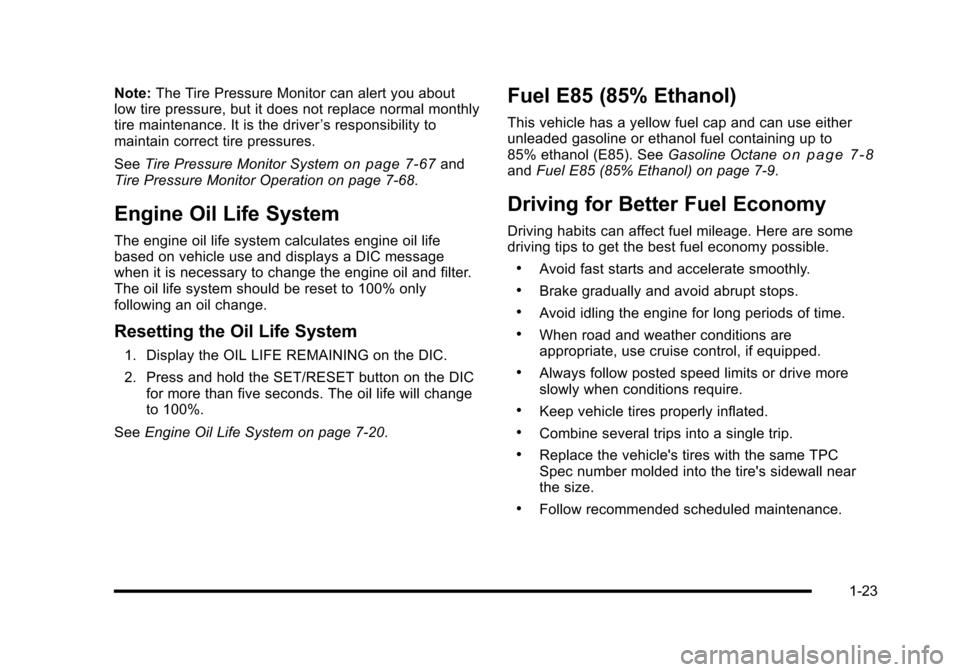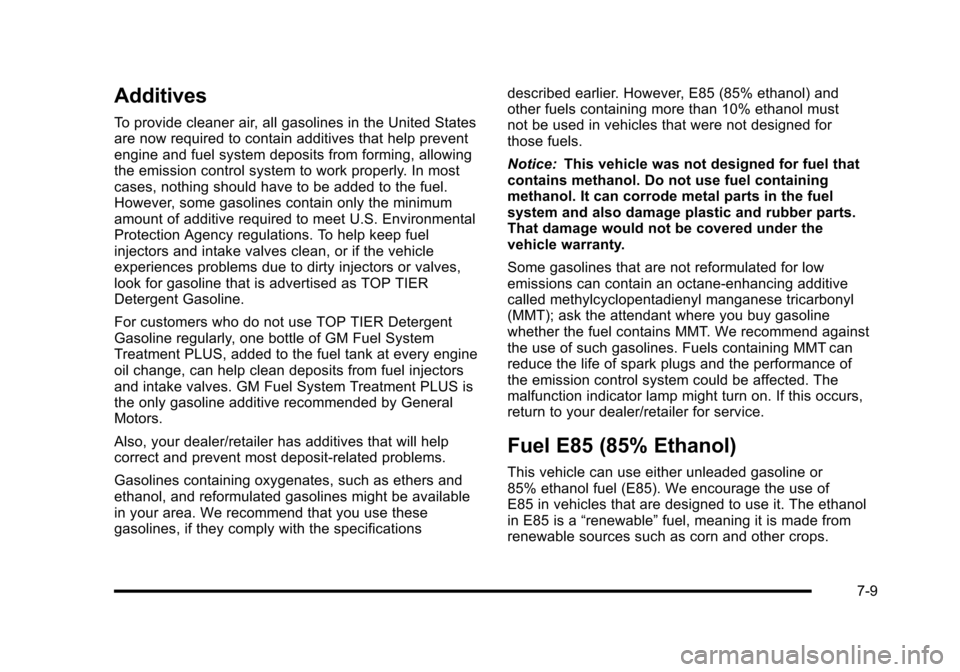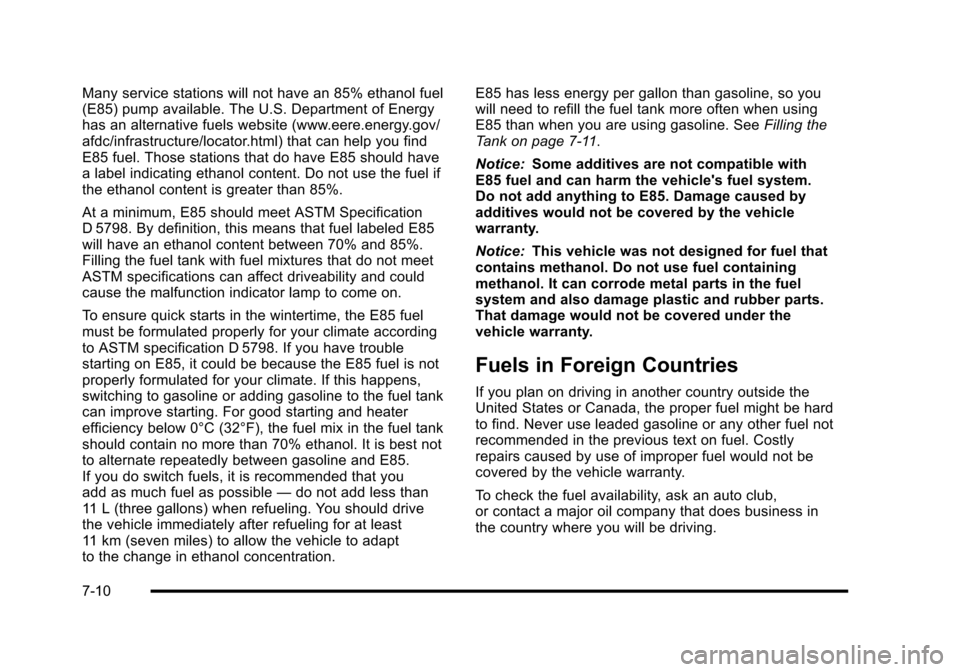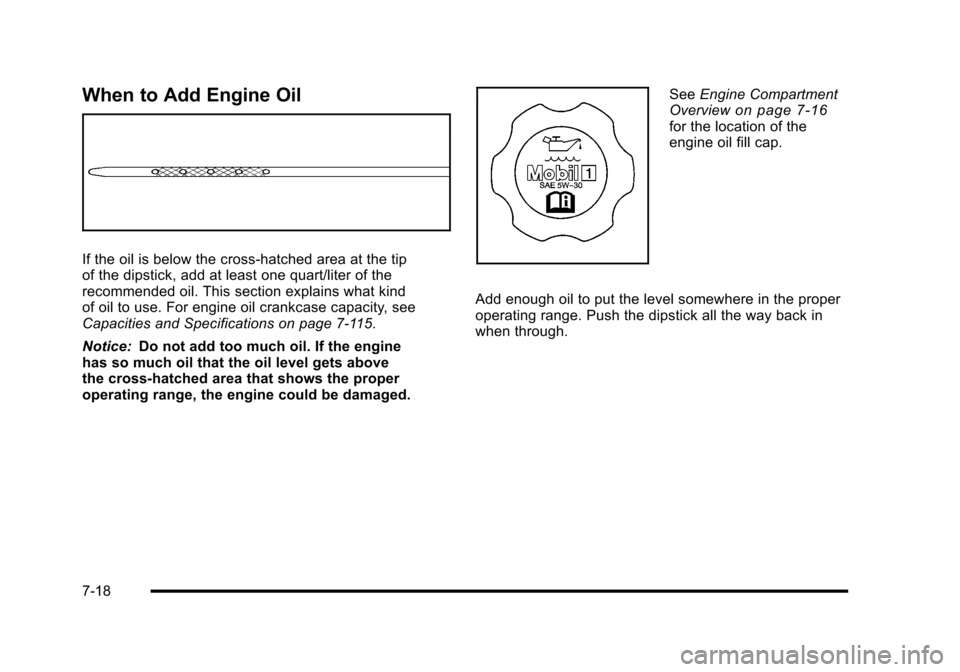recommended oil CADILLAC ESCALADE 2010 3.G Owners Manual
[x] Cancel search | Manufacturer: CADILLAC, Model Year: 2010, Model line: ESCALADE, Model: CADILLAC ESCALADE 2010 3.GPages: 616, PDF Size: 39.41 MB
Page 29 of 616

Note:The Tire Pressure Monitor can alert you aboutlow tire pressure, but it does not replace normal monthlytire maintenance. It is the driver’s responsibility tomaintain correct tire pressures.
SeeTire Pressure Monitor Systemon page 7!67andTire Pressure Monitor Operation on page 7!68.
Engine Oil Life System
The engine oil life system calculates engine oil lifebased on vehicle use and displays a DIC messagewhen it is necessary to change the engine oil and filter.The oil life system should be reset to 100% onlyfollowing an oil change.
Resetting the Oil Life System
1. Display the OIL LIFE REMAINING on the DIC.
2. Press and hold the SET/RESET button on the DICfor more than five seconds. The oil life will changeto 100%.
SeeEngine Oil Life System on page 7!20.
Fuel E85 (85% Ethanol)
This vehicle has a yellow fuel cap and can use eitherunleaded gasoline or ethanol fuel containing up to85% ethanol (E85). SeeGasoline Octaneo n p a g e 7!8andFuel E85 (85% Ethanol) on page 7!9.
Driving for Better Fuel Economy
Driving habits can affect fuel mileage. Here are somedriving tips to get the best fuel economy possible.
.Avoid fast starts and accelerate smoothly.
.Brake gradually and avoid abrupt stops.
.Avoid idling the engine for long periods of time.
.When road and weather conditions areappropriate, use cruise control, if equipped.
.Always follow posted speed limits or drive moreslowly when conditions require.
.Keep vehicle tires properly inflated.
.Combine several trips into a single trip.
.Replace the vehicle's tires with the same TPCSpec number molded into the tire's sidewall nearthe size.
.Follow recommended scheduled maintenance.
1-23
Page 236 of 616

Transmission Temperature
Press the trip/fuel button until TRANS TEMP displays.This display shows the temperature of the automatictransmission fluid in either degrees Fahrenheit (°F) ordegrees Celsius (°C).
Instantaneous Economy
If your vehicle has this display, press the trip/fuel buttonuntil INST ECON displays. This display shows thecurrent fuel economy at a particular moment and willchange frequently as driving conditions change. Thisdisplay shows the instantaneous fuel economy in milesper gallon (mpg) or liters per 100 kilometers (L/100 km).Unlike average economy, this screen cannot be reset.
The display may also show if the vehicle is currentlyin V4, V6 or V8 mode.
Average Vehicle Speed
Press the trip/fuel button until AVERAGE SPEEDdisplays. This display shows the average speed inmiles per hour (MPH) or kilometers per hour (km/h).
Blank Display
This display shows no information.
Vehicle Information Menu Items
T(Vehicle Information):Press this button to scrollthrough the following menu items:
Oil Life
Press the vehicle information button until OIL LIFEREMAINING displays. This display shows an estimateof the oil's remaining useful life. If you see 99% OILLIFE REMAINING on the display, that means 99% ofthe current oil life remains. The engine oil life systemwill alert you to change the oil on a schedule consistentwith your driving conditions.
When the remaining oil life is low, the CHANGEENGINE OIL SOON message will appear on thedisplay. See“CHANGE ENGINE OIL SOON”underDICWarnings and Messageson page 4!48. You shouldchange the oil as soon as you can. SeeEngine Oilonpage 7!17. In addition to the engine oil life systemmonitoring the oil life, additional maintenance isrecommended in the Maintenance Schedule in thismanual. SeeScheduled Maintenanceo n p a g e 8!3formore information.
4-44
Page 416 of 616

Other Rainy Weather Tips
Besides slowing down, other wet weather drivingtips include:
.Allow extra following distance.
.Pass with caution.
.Keep windshield wiping equipment in good shape.
.Keep the windshield washer fluid reservoir filled.
.Have good tires with proper tread depth.SeeTires on page 7!58.
.Turn off cruise control.
Before Leaving on a Long Trip
To prepare your vehicle for a long trip, consider havingit serviced by your dealer/retailer before departing.
Things to check on your own include:
.Windshield Washer Fluid:Reservoir full?Windows clean—inside and outside?
.Wiper Blades:In good shape?
.Fuel, Engine Oil, Other Fluids:All levels checked?
.Lamps:Do they all work and are lenses clean?
.Tires:Are treads good? Are tires inflated torecommended pressure?
.Weather and Maps:Safe to travel?Have up-to-date maps?
Highway Hypnosis
Always be alert and pay attention to your surroundingswhile driving. If you become tired or sleepy, find a safeplace to park your vehicle and rest.
Other driving tips include:
.Keep the vehicle well ventilated.
.Keep interior temperature cool.
.Keep your eyes moving—scan the roadahead and to the sides.
.Check the rearview mirror and vehicleinstruments often.
6-26
Page 455 of 616

Additives
To provide cleaner air, all gasolines in the United Statesare now required to contain additives that help preventengine and fuel system deposits from forming, allowingthe emission control system to work properly. In mostcases, nothing should have to be added to the fuel.However, some gasolines contain only the minimumamount of additive required to meet U.S. EnvironmentalProtection Agency regulations. To help keep fuelinjectors and intake valves clean, or if the vehicleexperiences problems due to dirty injectors or valves,look for gasoline that is advertised as TOP TIERDetergent Gasoline.
For customers who do not use TOP TIER DetergentGasoline regularly, one bottle of GM Fuel SystemTreatment PLUS, added to the fuel tank at every engineoil change, can help clean deposits from fuel injectorsand intake valves. GM Fuel System Treatment PLUS isthe only gasoline additive recommended by GeneralMotors.
Also, your dealer/retailer has additives that will helpcorrect and prevent most deposit!related problems.
Gasolines containing oxygenates, such as ethers andethanol, and reformulated gasolines might be availablein your area. We recommend that you use thesegasolines, if they comply with the specifications
described earlier. However, E85 (85% ethanol) andother fuels containing more than 10% ethanol mustnot be used in vehicles that were not designed forthose fuels.
Notice:This vehicle was not designed for fuel thatcontains methanol. Do not use fuel containingmethanol. It can corrode metal parts in the fuelsystem and also damage plastic and rubber parts.That damage would not be covered under thevehicle warranty.
Some gasolines that are not reformulated for lowemissions can contain an octane-enhancing additivecalled methylcyclopentadienyl manganese tricarbonyl(MMT); ask the attendant where you buy gasolinewhether the fuel contains MMT. We recommend againstthe use of such gasolines. Fuels containing MMT canreduce the life of spark plugs and the performance ofthe emission control system could be affected. Themalfunction indicator lamp might turn on. If this occurs,return to your dealer/retailer for service.
Fuel E85 (85% Ethanol)
This vehicle can use either unleaded gasoline or85% ethanol fuel (E85). We encourage the use ofE85 in vehicles that are designed to use it. The ethanolin E85 is a“renewable”fuel, meaning it is made fromrenewable sources such as corn and other crops.
7-9
Page 456 of 616

Many service stations will not have an 85% ethanol fuel(E85) pump available. The U.S. Department of Energyhas an alternative fuels website (www.eere.energy.gov/afdc/infrastructure/locator.html) that can help you findE85 fuel. Those stations that do have E85 should havea label indicating ethanol content. Do not use the fuel ifthe ethanol content is greater than 85%.
At a minimum, E85 should meet ASTM SpecificationD 5798. By definition, this means that fuel labeled E85will have an ethanol content between 70% and 85%.Filling the fuel tank with fuel mixtures that do not meetASTM specifications can affect driveability and couldcause the malfunction indicator lamp to come on.
To ensure quick starts in the wintertime, the E85 fuelmust be formulated properly for your climate accordingto ASTM specification D 5798. If you have troublestarting on E85, it could be because the E85 fuel is notproperly formulated for your climate. If this happens,switching to gasoline or adding gasoline to the fuel tankcan improve starting. For good starting and heaterefficiency below 0°C (32°F), the fuel mix in the fuel tankshould contain no more than 70% ethanol. It is best notto alternate repeatedly between gasoline and E85.If you do switch fuels, it is recommended that youadd as much fuel as possible—do not add less than11 L (three gallons) when refueling. You should drivethe vehicle immediately after refueling for at least11 km (seven miles) to allow the vehicle to adaptto the change in ethanol concentration.
E85 has less energy per gallon than gasoline, so youwill need to refill the fuel tank more often when usingE85 than when you are using gasoline. SeeFilling theTank on page 7!11.
Notice:Some additives are not compatible withE85 fuel and can harm the vehicle's fuel system.Do not add anything to E85. Damage caused byadditives would not be covered by the vehiclewarranty.
Notice:This vehicle was not designed for fuel thatcontains methanol. Do not use fuel containingmethanol. It can corrode metal parts in the fuelsystem and also damage plastic and rubber parts.That damage would not be covered under thevehicle warranty.
Fuels in Foreign Countries
If you plan on driving in another country outside theUnited States or Canada, the proper fuel might be hardto find. Never use leaded gasoline or any other fuel notrecommended in the previous text on fuel. Costlyrepairs caused by use of improper fuel would not becovered by the vehicle warranty.
To check the fuel availability, ask an auto club,or contact a major oil company that does business inthe country where you will be driving.
7-10
Page 464 of 616

When to Add Engine Oil
If the oil is below the cross-hatched area at the tipof the dipstick, add at least one quart/liter of therecommended oil. This section explains what kindof oil to use. For engine oil crankcase capacity, seeCapacities and Specifications on page 7!115.
Notice:Do not add too much oil. If the enginehas so much oil that the oil level gets abovethe cross-hatched area that shows the properoperating range, the engine could be damaged.
SeeEngine CompartmentOverviewon page 7!16for the location of theengine oil fill cap.
Add enough oil to put the level somewhere in the properoperating range. Push the dipstick all the way back inwhen through.
7-18
Page 466 of 616

Engine Oil Additives / Engine Oil
Flushes
Do not add anything to the oil. The recommended oilswith the starburst symbol that meet GM standards areall that is needed for good performance and engineprotection.
Engine oil system flushes are not recommended andcould cause engine damage not covered by the vehiclewarranty.
Engine Oil Life System
When to Change Engine Oil
This vehicle has a computer system that indicates whento change the engine oil and filter. This is based onengine revolutions and engine temperature, and not onmileage. Based on driving conditions, the mileage atwhich an oil change is indicated can vary considerably.For the oil life system to work properly, the system mustbe reset every time the oil is changed.
When the system has calculated that oil life has beendiminished, it indicates that an oil change is necessary.A CHANGE ENGINE OIL SOON message comes on.SeeDIC Warnings and Messageson page 4!48.Change the oil as soon as possible within the next600 miles (1 000 km). It is possible that, if driving underthe best conditions, the oil life system might not indicatethat an oil change is necessary for over a year.However, the engine oil and filter must be changed atleast once a year and at this time the system must bereset. Your dealer/retailer has trained service peoplewho will perform this work using genuine parts andreset the system. It is also important to check the oilregularly and keep it at the proper level.
If the system is ever reset accidentally, the oil must bechanged at 3,000 miles (5 000 km) since the last oilchange. Remember to reset the oil life systemwhenever the oil is changed.
7-20
Page 476 of 616

What to Use
{WARNING:
Adding only plain water to the cooling system can
be dangerous. Plain water, or some other liquid
such as alcohol, can boil before the proper
coolant mixture will. The vehicle's coolant warning
system is set for the proper coolant mixture. With
plain water or the wrong mixture, the engine could
get too hot but you would not get the overheat
warning. The engine could catch fire and you or
others could be burned. Use a 50/50 mixture of
clean, drinkable water and DEX-COOL®coolant.
Use a 50/50 mixture of clean, drinkable water andDEX-COOL®coolant. If using this mixture, nothingelse needs to be added. This mixture:
.Gives freezing protection down to!34°F (!37°C),outside temperature.
.Gives boiling protection up to 265°F (129°C),engine temperature.
.Protects against rust and corrosion.
.Will not damage aluminum parts.
.Helps keep the proper engine temperature.
Notice:If an improper coolant mixture is used, theengine could overheat and be badly damaged. Therepair cost would not be covered by the vehiclewarranty. Too much water in the mixture can freezeand crack the engine, radiator, heater core, andother parts.
Notice:If extra inhibitors and/or additives are usedin the vehicle's cooling system, the vehicle could bedamaged. Use only the proper mixture of the enginecoolant listed in this manual for the cooling system.SeeRecommended Fluids and Lubricantsonpage 8!10for more information.
7-30
Page 487 of 616

Checking Brake Fluid
Check brake fluid by looking at the brake fluid reservoir.SeeEngine Compartment Overview on page 7!16.
The fluid level should beabove MIN. If it is not,have the brake hydraulicsystem checked to see ifthere is a leak.
After work is done on the brake hydraulic system, makesure the level is above the MIN but not over theMAX mark.
What to Add
Use only new DOT 3 brake fluid from a sealedcontainer. SeeRecommended Fluids and Lubricantsonpage 8!10.
Always clean the brake fluid reservoir cap and the areaaround the cap before removing it. This helps keep dirtfrom entering the reservoir.
{WARNING:
With the wrong kind of fluid in the brake hydraulic
system, the brakes might not work well. This could
cause a crash. Always use the proper brake fluid.
Notice:
.Using the wrong fluid can badly damage
brake hydraulic system parts. For example,
just a few drops of mineral-based oil, such
as engine oil, in the brake hydraulic system
can damage brake hydraulic system parts so
badly that they will have to be replaced. Do
not let someone put in the wrong kind of
fluid.
.If brake fluid is spilled on the vehicle's
painted surfaces, the paint finish can be
damaged. Be careful not to spill brake fluid
on the vehicle. If you do, wash it off
immediately. SeeWashing Your Vehicleon
page 7!102.
7-41
Page 544 of 616

Spare Tire
Your vehicle, when new, had a fully-inflated spare tire.A spare tire may lose air over time, so check its inflationpressure regularly. SeeInflation - Tire Pressureonpage 7!65andLoading the Vehicleon page 6!32forinformation regarding proper tire inflation and loadingyour vehicle. For instruction on how to remove, install orstore a spare tire, seeRemoving the Flat Tire andInstalling the Spare Tireon page 7!86andStoring aFlat or Spare Tire and Tools on page 7!94.
After installing the spare tire on your vehicle, you shouldstop as soon as possible and make sure the spare iscorrectly inflated. The spare tire is made to perform wellat speeds up to 70 mph (112 km/h) at the recommendedinflation pressure, so you can finish your trip.
Have the damaged or flat road tire repaired or replacedas soon as you can and installed back onto yourvehicle. This way, a spare tire will be available in caseyou need it again. Do not mix tires and wheels ofdifferent sizes, because they will not fit. Keep yourspare tire and its wheel together.
Appearance Care
Interior Cleaning
The vehicle's interior will continue to look its best if it iscleaned often. Although not always visible, dust and dirtcan accumulate on the upholstery. Dirt can damagecarpet, fabric, leather, and plastic surfaces. Regularvacuuming is recommended to remove particles fromthe upholstery. It is important to keep the upholsteryfrom becoming and remaining heavily soiled. Soilsshould be removed as quickly as possible. Thevehicle's interior may experience extremes of heat thatcould cause stains to set rapidly.
Lighter colored interiors may require more frequentcleaning. Use care because newspapers and garmentsthat transfer color to home furnishings may also transfercolor to the vehicle's interior.
When cleaning the vehicle's interior, only use cleanersspecifically designed for the surfaces being cleaned.Permanent damage may result from using cleaners onsurfaces for which they were not intended. Use glasscleaner only on glass. Remove any accidentalover-spray from other surfaces immediately. To preventover-spray, apply cleaner directly to the cleaning cloth.
7-98